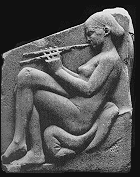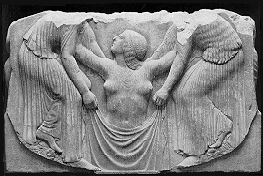 |
 |
 |
| A girl, naked except for a scarf around her hair, is sitting playing the double pipes. Her right leg is crossed above the knee, showing some problems with representation (where is her far hip?) Her hands are badly damaged. | A woman, or goddess, wearing a thin, pehaps wet, shift which reveals all forms of her body is held by two attendants. She is hidden from the waist down by a cloth. There is a play of upward rising curves and overlapping planes in the use of texture and movement. The left attendant wears a Doric tunic: a Peplos. The right wears an Ionian shift, a Chiton, without the upper garment. Both are carved to show the body form from beneath. Their bare feet are on stony ground, perhaps a seashore, giving some rudimentary hint of recession and setting. Their heads and shoulders are lost due to damage. | |
| The sculpture's use of drapery and its play with material texture, its rudimentary recession, its facial types, action and problem in rendering movement, all suggest that it is a piece from the "Severe" or "Transitional" Period, where Greek artists elaborated and expanded Archaic forms before resolving them in the Classical style. The Ludovisi Throne is dated to c. 460 B.C. However, it does not stand in the central stream of Greek art. The use of dissimilar garments (the western Doric juxtaposed with the eastern Ionian,) the engraved detailing of the front contrasting with the simplicity of the sides, and the new subject matter (the girl is one of the first female nudes in Greek Sculpture) suggests that the throne may be best placed originating from an area peripheral to mainland Greece. It has been linked stylistically and thematically with Locri Epizefiri in the south of Italy. |